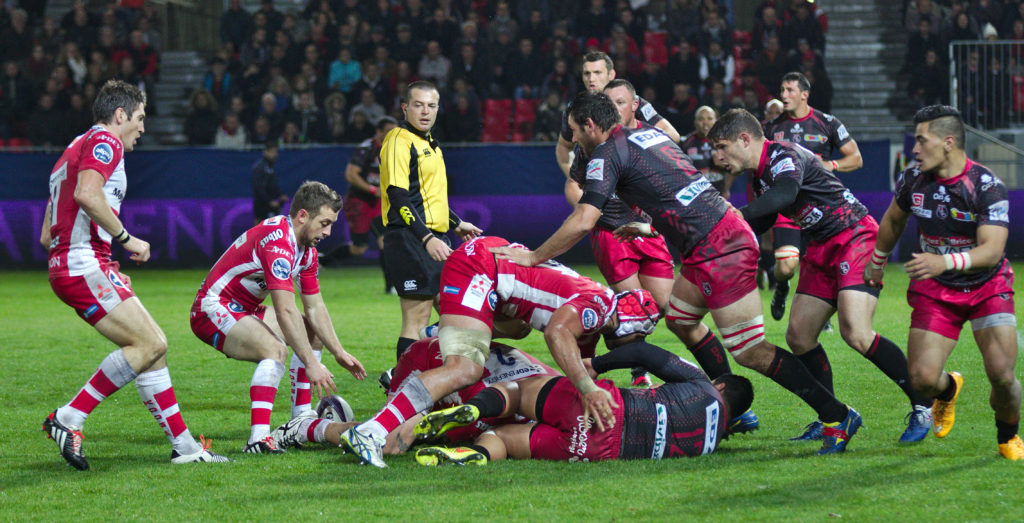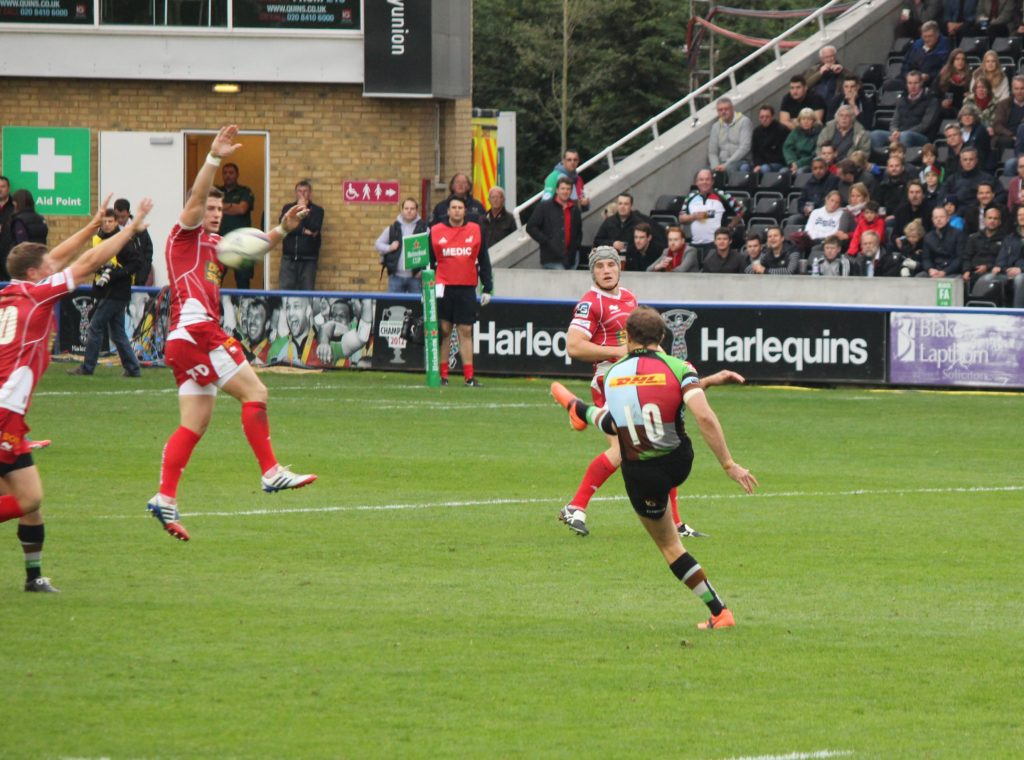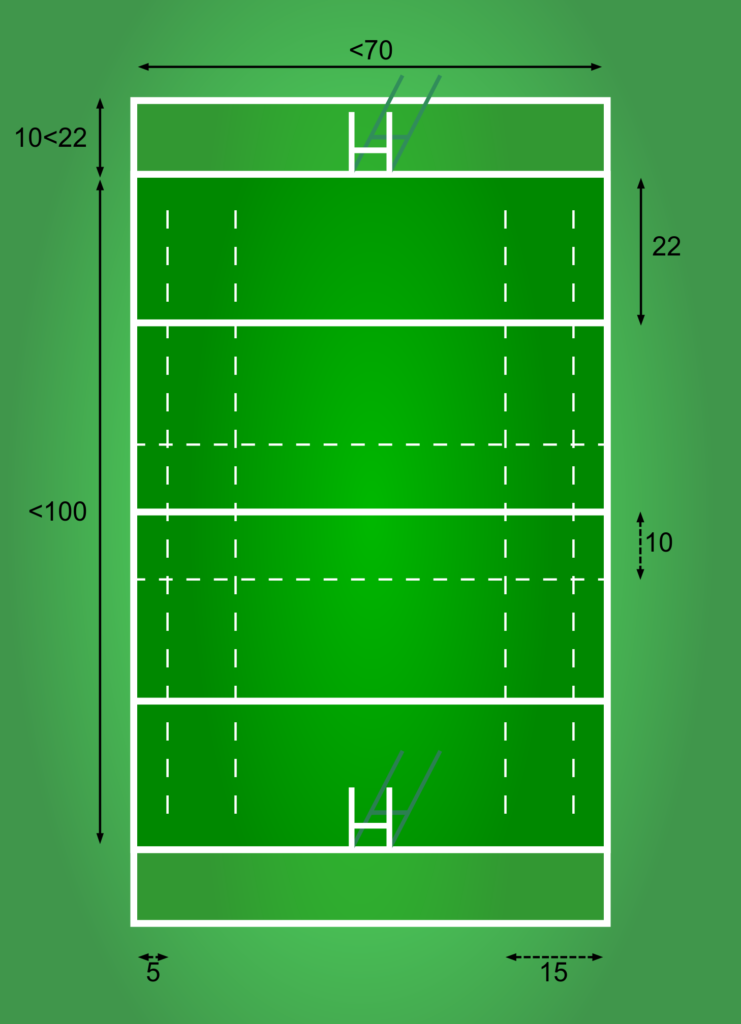The game is played with two teams of 15 players each.
Each team can carry, pass or kick the ball into the end zone to score as many points as possible. The team that scores the most points is declared the winner of the match.
The two teams play for 2 40-minute halves, with a maximum 15-minute break in between. A rugby match therefore lasts 80 minutes.
A referee controls the match with the help of 2 linesmen.
There are no time-outs, except at the discretion of the referee, who may give an injured player one minute to decide whether to continue playing or not.
Each team is allowed only 7 substitutions per match. Six of these substitutions are at the team’s discretion, and one is for injury.
Once a player has been replaced, he or she may not return to the game. The only time a player may return to the game is if he has been temporarily replaced for an open injury, but he must return within 10 minutes of the change or be permanently replaced.





Play begins with a kick-off from the center of the field. The team with the ball makes every effort to score a try once the ball is in play.
A try is scored when a player flattens the ball on the ground in the opponent’s in-goal. The team then receives 5 points.
After a try has been scored, the team has the option of converting the try by kicking the ball over the opponent’s crossbar and between the goalposts, thus scoring 2 additional points.
The ball must be placed perpendicular to where it was flattened. The kicker chooses the distance at which to place the ball for the conversion kick.
If the opposing team commits a penalty, the team receiving the foul may attempt a 3-point penalty kick, either at goal or using the drop-goal, from anywhere on the field.
During play, players advance towards their goal, but the ball cannot be passed forward. The player must pass the ball back to his team-mates while moving forward.
The forward progress of the player carrying the ball may be impeded by a tackle by that player. Once a player has been tackled, he must immediately pass or release the ball and move away from it.
RUGBY VOCABULARY
- Dead ball : when the ball is no longer in play (when the referee whistles for a scrum, a touch, a kick-off or after a conversion).
- Blindside: the closed side of the field.
- Cape: every time a player plays a match for his national team, he receives a “cape”.
- Drop goal : a kick to the posts made at any time by a team – if successful, it’s worth three points, but the ball must touch the ground before being kicked.
- Chandelle: a kick that is high in the air.
- Skimming kick: a kick that causes the ball to bounce and roll erratically across the field.
- Forward: when a player drops the ball in front of him to pass to a partner in front of him; the ball is then awarded to the other team in a scrum.
- Mark: a place on the field designated by the referee as the place where a scrum is to take place.
- Offside: a player is offside when he is in front of a team-mate who is holding the ball or who played the ball last; if he tries to take part in the game, he commits a penalty.
- Penalty: any infringement of the rules of the game which results in the other team being kicked.
- Penalty try: the awarding of a try due to flagrant anti-game by an opposing party which prevents an obvious try from being scored.
- Penalty kick: a kick to the ground, with the ball positioned in a notch in the turf, on a small pile of sand or on a tee.
- Referee: the only judge and timekeeper of the match.
- Kick-off: the kick-off restarts play after half-time or after points have been scored.
- Touch judge: an official placed on either side of the field to mark where balls have left the field and to judge goal kicks.
- Ruck: one or more players from each team, who are standing and in contact, approach the ball on the ground. Once the circle is formed, players cannot use their hands to catch the ball, only their feet. The ruck ends when the ball leaves the scrum or when a scrum is ordered by the referee.
- Maul: one or more players from each team stand in physical contact around a player carrying the ball. A maul ends when the ball is on the ground, when a ruck, the ball or a player carrying the ball leaves the maul, or when a scrum is ordered by the referee.
- Scrum: a sequence of play formed by the eight forwards of each team. The ball is thrown into the middle of the pack and each team pushes against the other team’s eight men to compete for possession of the ball. Scrimmages resume play in the event of certain minor infringements. The scrum ends when one team gains possession of the ball and moves down the field.
- Touch: Both teams line up opposite each other, but one team then throws the ball into the middle of the two rows. Touch resumes play after the ball, or a player with the ball in his hands, has left the field.
POSTS
A rugby team is made up of 15 players with different positions. Each has a specific number and individual responsibilities.
The forwards
They tend to be the heavyweights of the team because they push, pull, tackle a lot and use their physical strength to win possession of the ball.
1: Left prop
2: Talon
3: Right prop
4: Second row
5: Second row
6: Third row wing (closed side)
7: Third row wing (open side)
8: Third-row center
Full-backs
These are the smallest and fastest players, who run or kick the ball once the team has possession.
9: Scrum-half
10: Fly-half
11: Three-quarter wing (left)
12: Center or center three-quarter
13: Center or center three-quarter
14: Three-quarter wing or winger (right)
15: Fullback
POINTS
The aim of rugby is to score more points than the opposing team. This is done in four different ways.
Tries
The best way to score points is to score a try, which means flattening the ball in the opponent’s goal area or goal line.
This is worth 5 points and gives that team the right to try a conversion kick.
Transformation
This kick is worth 2 additional points.
The conversion kick is taken perpendicular to where the ball was originally flattened. It is therefore preferable to score as close to the goalposts as possible to benefit from a better position.
The scorer is free to choose the distance from the in-goal line at which to take the kick.
Penalty kicks
Penalties for various fouls in the game can be used to take a penalty kick.
This is worth 3 points.
Drop
A drop, which occurs when the player drops the ball on the ground and hits it just as it bounces, is worth 3 points if it goes through the uprights.
THE RULES OF THE GAME
When a tackle is made in rugby, the requirements are that the tackler drops the tackled player, who then drops the ball so that the players who are standing can use it.
An advantage simply means that when one team makes a mistake, the other team can try to capitalize on it, rather than the referee stopping the action immediately. If the players are unable to capitalize on the mistake, play resumes where the original foul occurred.
There are specific offside rules for different phases of the game, but the most important thing to remember is that a player cannot take part in the game if he is in front of a team-mate who played the ball last, or if he is behind the ball when the opponent has it.
Common fouls
Offside
A player is offside in current play if he is in front of a team-mate who is carrying the ball, or in front of a team-mate who played the ball last. In this case, he must not interfere with play.
It is also forbidden to kick the ball to a team-mate behind.
Forward pass
This is a pass made to a player who is in front of him when he receives the ball. A player is not allowed to pass the ball to a team-mate in front of him.
Forwards
If a player drops the ball “forwards” – i.e. towards the opposing team’s goal line – or loses possession of the ball and goes forward, a scrum is whistled and the non-offending team receives the throw-in.
This is known as a “hand foul”.
High tackle
Tackling the ball carrier above the shoulder line is forbidden.
Obstruction
Attacking or interfering with someone not carrying the ball. Interfering with an opponent who is trying to attack the ball carrier.
Failure to release the ball
Not releasing the ball when tackled to the ground.
Unfair play
Play judged by the referee to be dangerous, obstructive or unfair. The offending player is penalized, possibly sent to the temporary exclusion zone (10 minutes), or even expelled.
RUGBY XV CHRONOLOGY
From the 1400s to the 1800s, many types of soccer were played throughout Great Britain.
In 1823, a student from Rugby, England, named William Webb Ellis, grabbed the ball by the hand during a match and ran towards the goal in defiance of the rules, giving birth to rugby.
The sport became popular throughout the UK in the 1850s and 1860s.
1857: the first rugby match in Scotland, Edinburgh University vs. Edinburgh Academicals.
1869: first rugby match in the USA, Rutgers vs Princeton.
1871: the Rugby Football Union is founded and organizes the first international match between England and Scotland.
1875: Oxford vs Cambridge, teams were limited to fifteen players each.
1876: tries had no point value, but were used to determine the winners in the event of a tie. America adopted rugby rules requiring players who had been tackled to release the ball.
1881: referees are present at international matches, but only observe from the sidelines.
1891: the RFU (English Rugby Union) confirms that all teams are limited to 15 players, that 2 points are awarded for a try, 3 for a penalty and for a conversion, and 4 points for a drop.
1896: referees have total control of the game and the concept of “advantage” is introduced.
1908: France wins the Olympic gold medal.
1906: the concept of the forward pass is introduced in the United States.
1920: The United States wins the Olympic gold medal.
1924: USA wins Olympic gold medal in rugby, the last time rugby is considered an Olympic sport until 2016.
1932: wingers must join the scrum and the 3-forward line is compulsory.
1949: Drops are worth only 3 points.
1958: a minimum distance of 4.6m is no longer required for penalty kicks.
1969: the “Australian Dispensation” rule is adopted, requiring that touch kicks outside the 22-meter line must first see the ball bounce on the field of play before going out.
1971: Tries are now worth 4 points, and the Gaelic Athletic Association no longer prohibits its members from playing rugby on the grounds that it is a foreign game.
1992: Tries are now worth 5 points.
1996: The Women’s Six Nations Tournament is launched.
2000: Italy joins the V Nations Tournament, renamed the VI Nations Tournament.
2003: World Rugby publishes its ranking of the best men’s 15-a-side rugby teams.